-
*Astrella.
User deleted
The Mysteries of Rosslyn Chapel - Scotland - Part Two
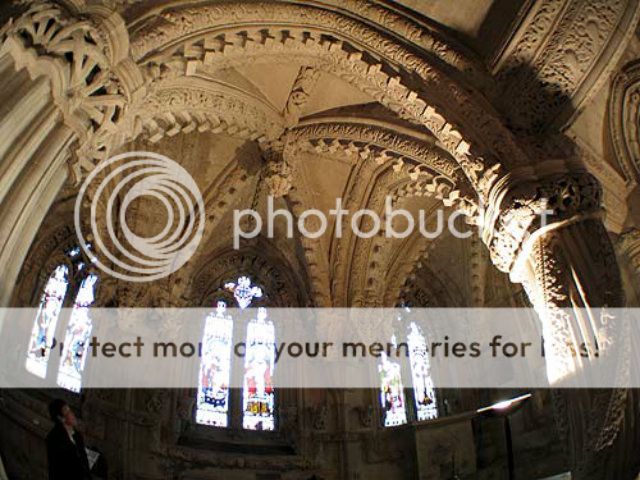
Eight Pointed Arch in The Lady Chapel and Journeyman Pillar (left) and Apprentice Pilllar (right)
The Apprentice Pilllar
The "Apprentice Pillar", or "Prentice Pillar", gets its name from a legend dating from the 18th century involving the master mason in charge of the stonework in the chapel and his young apprentice.
According to the legend, reminiscent of the story of Hiram Abiff, the master mason did not believe that the apprentice could perform the complicated task of carving the column without seeing the original which formed the inspiration for the design.
The master mason travelled to see the original himself, but upon his return was enraged to find that the upstart apprentice had completed the column anyway. In a fit of jealous anger the mason took up his mallet and struck the apprentice on the head, killing him.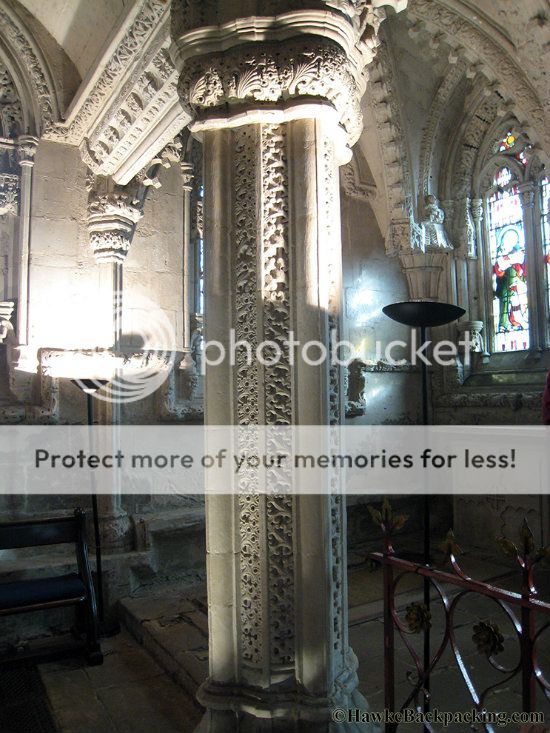
The Master's Pilar
The legend concludes that as punishment for his crime, the master mason's face was carved into the opposite corner to forever gaze upon his apprentice's pillar.
Allegedly Apprentice face carved
Author Henning Klovekorn has proposed that the pillar is representative of one of the roots of the Nordic Yggdrasil tree, prominent in Germanic and Norse mythology.
He compares the eight dragons at the base of the pillar to the dragons found eating away at the base of the Yggdrasil root and, pointing out that at the top of the pillar is carved tree foliage, argues that the Nordic/Viking association is plausible considering the many auxiliary references in the chapel to Celtic and Norse mythology .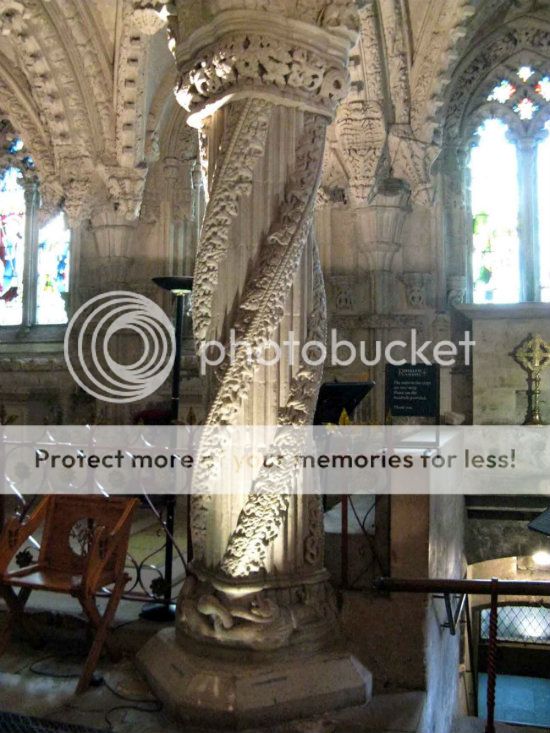
The Apprentice Pillar
Plants
The authors Robert Lomas and Christopher Knight have hypothesized that some carvings in the chapel represent ears of new world corn or maize, a plant which was unknown in Europe at the time of the chapel's construction; Knight and Lomas view these carvings as evidence supporting the idea that Henry I Sinclair, Earl of Orkney, traveled to the Americas well before Columbus.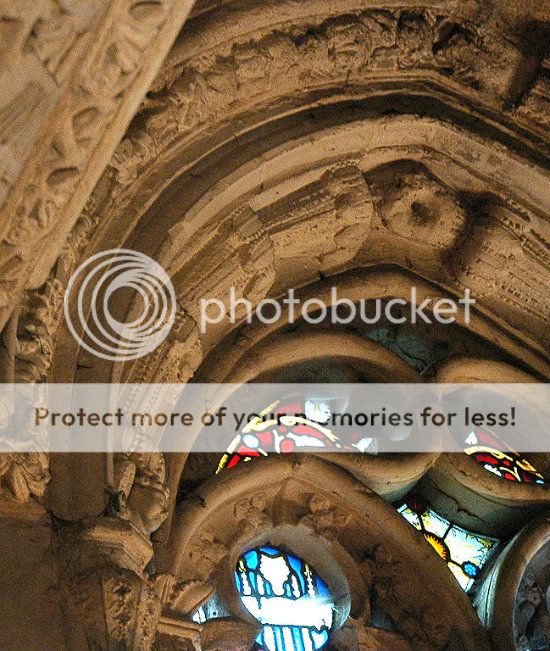
American corn (maize) surrounds the window in the broadest arch
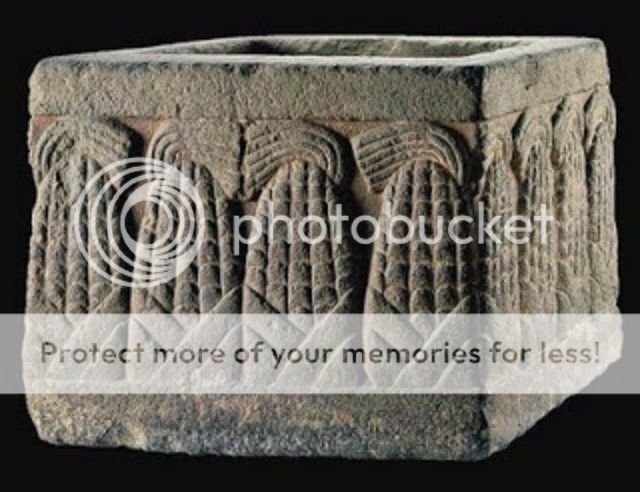
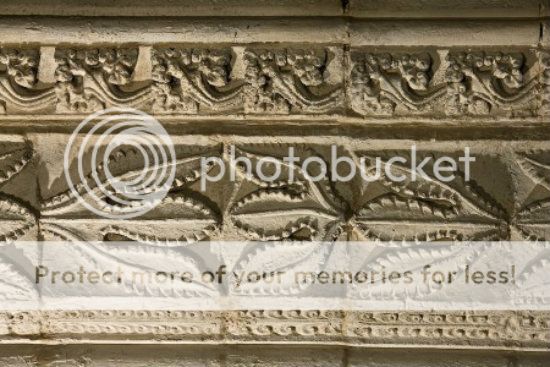
Aloe Cactus
Medieval scholars interpret these carvings as stylised depictions of wheat, strawberries or lilies.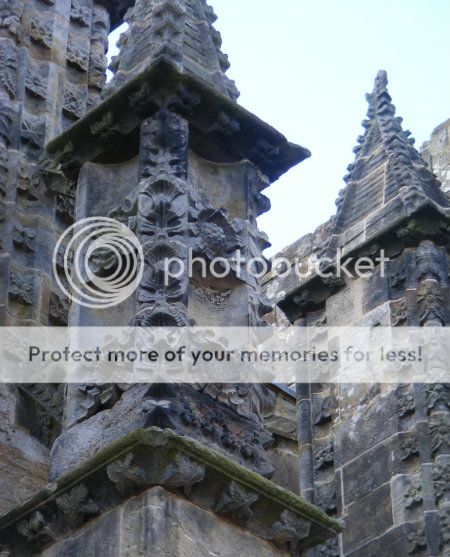
Flowers carving on the roof
Green Men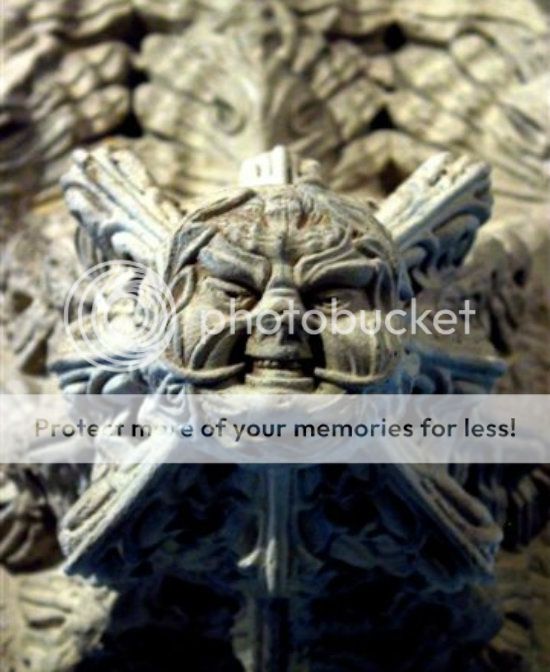
The 'Green Men' are carvings of human faces with greenery all around them, often growing out of their mouths. They are thought to be a symbol of renewal and fertility, pre-Christian in origin. In Rosslyn they are found in all areas of the chapel, with one example in the Lady Chapel, between the two middle altars of the east wall. There are more than 110 carvings of Green Men in and around the chapel.
The Crypt
The chapel has also acted as a burial place for several generations of the Sinclairs — a crypt was once accessible from a descending stair at the rear of the chapel. This crypt has for many years been sealed shut, which may explain the recurrent legends that it is merely a front to a more extensive subterranean vault containing (variously) the mummified head of Jesus Christ, the Holy Grail, the treasure of the Templars, or the original crown jewels of Scotland.
In 1837 when the 2nd Earl of Rosslyn died, his wish was to be buried in the original vault; exhaustive searches over the period of a week were made, but no entrance to the original vault was found and he was buried beside his wife in the Lady Chapel.
Stone inside the crypt
Rooftop pinnacle
The pinnacles on the rooftop have been subject to interest during renovation work in 2010. Nesting jackdaws had made the pinnacles unstable and as such had to be dismantled brick by brick revealing the existence of a chamber specifically made by the stonemasons to harbour bees.
The hive, now abandoned, has been sent to local bee keepers to identify.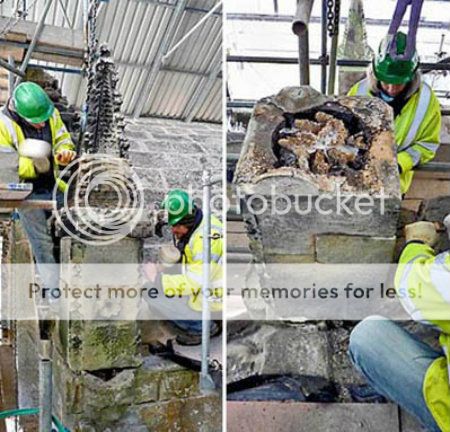
Other carvings at Rosslyn which provide evidence of a link to the esoteric symbolism of The Knights Templar and/or Freemasonry include the Green Man, which is also seen in Templar churches in Jerusalem ; the fallen and bound angel (Lucifer) and the knight on horse back.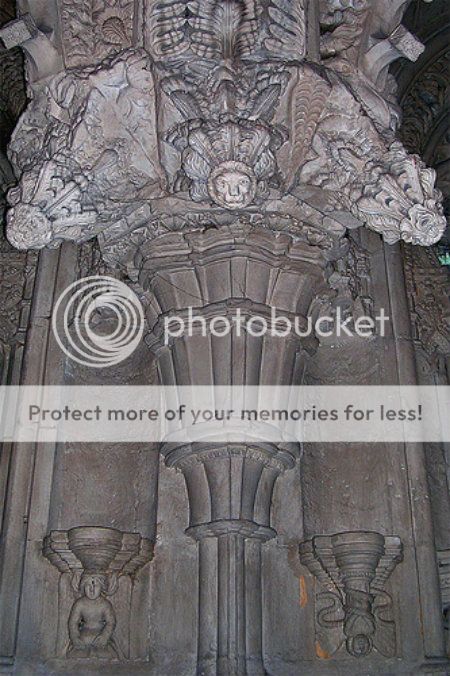
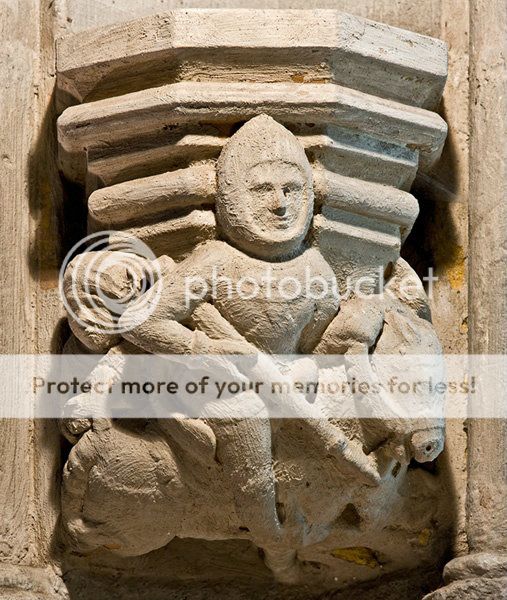
The Knight
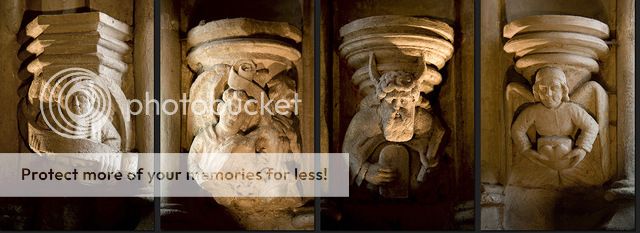

The 'Lamb of God' (Agnus Dei) a device used on Templar seals (particularly in the Languedoc region of southern France) to represent St John the Baptist.
'Musical' boxes
Next to the Apprentice Pillar is the Journeyman Pillar, which displays a series of pentagrams supporting musical angels; the angels replace the missing top triangle in each pentagram. Above the angels, and throughout the Lady Chapel, are cubes carved with symetrical patterns.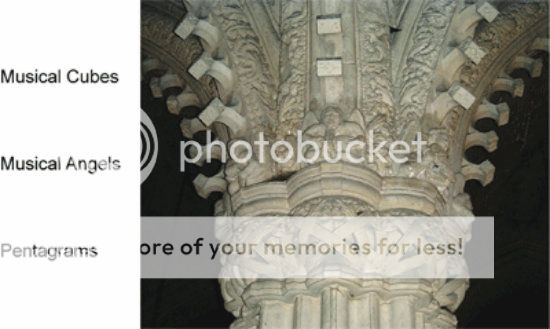
Thomas Mitchell and his son Stuart claim that a total of 215 “musical cubes” in the pillars and arches of Rosslyn Chapel are found to match 13 unique geometrical sound patterns, known as Chladni figures or Cymatics. These patterns are produced when a metal plate is sprinkled with salt or powder and vibrated by sound frequencies.
Documented first by Ernst Chladni in 1787 (300 years after Rosslyn Chapel was finished), the patterns can range from primitive polygons like triangles, pentagons and hexagons to beautiful Mandela-like patterns, depending on which frequencies are used.
According to Richard Merrick , to the medieval Catholic Church, Egyptian ideas of resonance were considered part of a Pantheistic belief of God in nature and were a direct threat to the Christian belief of God outside of nature.
As a result, the geometry of the pentagram and certain resonant intervals were considered unfit for use in the Church. This was especially true for the musical interval of three whole tones (six half-steps) known as the tritone.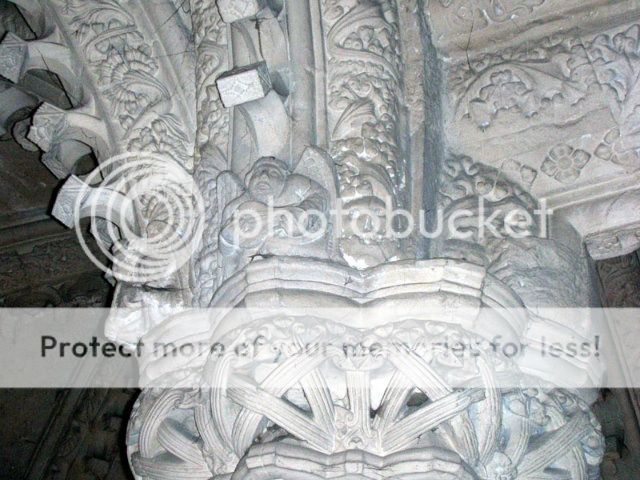
Known as Diabolus in Musica, or the Devil in Music, the tritone is very strongly related to this ancient understanding of resonance, sharing what we will call for now, an “inverse harmonic relationship” with a consonant major sixth. The Rosslyn stave angel emphasizes this fact by pointing to the part of the tritone interval known as the “leading tone”. As a matter of fact, the melody in the cubes emphasizes the tritone in a way that would have been unacceptable to the Catholic Church in the 15th century.
Banned by Pope Gregory IX in 1234, the tritone was and still is outlawed in Catholic music. As a result, the Freemasons hid their use of this forbidden interval by encoding it as cymatic symbols in the chapel architecture.
This was their way of preserving what they considered sacred Egyptian knowledge at a time when Europe was hostile to such beliefs. But there is another twist to this story that takes the concept of resonance to an even higher level of theosophical symbolism.
Jeff Nisbit offers some interesting insights into alterations made to Rosslyn during restoration with respect to the the work of John and Stuart Mitchell.The Rosslyn Stave Angel - Music Cipher
by Stuart Mitchell Music
Conservation programme
The chapel is currently undergoing an extensive programme of conservation. This includes work to the roof, the stone, the carvings, the stained glass and the organ. A steel canopy was erected over the chapel roof for fourteen years. This was to prevent further rain damage to the church and also to give it a chance to dry out properly. Three human skeletons were found during the restoration.
Major stonework repairs were completed by the end of 2011. The last major scaffolding was removed in August 2010.
A new visitor centre opened in July 2011. The chapel's stained-glass windows and organ were fully restored. New lighting and heating were installed.
The expected cost of the restoration work is around £13 million, with about £3.7 million being spent on the Visitor Centre. Funding has come from various sources including Heritage Lottery Fund, Historic Scotland and the environmental body, WREN.
Actor Tom Hanks also made a donation.
Photography and video have been forbidden in the chapel since 2008. The chapel sells commercially produced photos in its shop.
Fictional references
- The Chapel is the setting for part of Dan Brown's 2003 novel The Da Vinci Code (and for part of the subsequent 2006 film of the same name).
- In Ian Rankin's novel Set in Darkness a fanatic who wants to get his hands on the 400,000 pounds left by a tramp who committed suicide gives DI John Rebus and DS Siobhan Clarke a tour of Rosslyn Chapel.
The Movie, background the Rosslyn Chapel Bapistry
Source: www.the-big-picture.org.uk/wp/?page_id=3912
http://en.wikipedia.org/wiki/Rosslyn_Chapel.
The Mysteries of Rosslyn Chapel - Scotland - Part Two1 Aprile 2014 |


